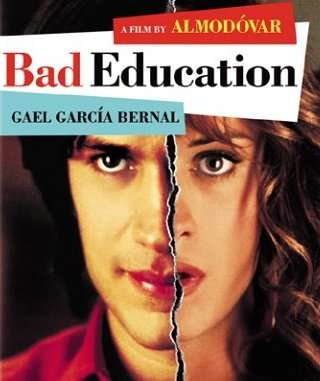Bad Education

Bad Education, or La Mala Education is a 2004 Spanish drama film directed by Pedro Almodovar and starring Gael García Bernal, Fele Martínez and Daniel Giménez Cacho. The film centers on Ignacio and Enrique, two men who meet again as adults after spending years apart. Ignacio (who goes by Ángel now) is an aspiring actor who wants Enrique to produce and direct his script, "The Visit". Enrique's interest is piqued when Ignacio tells him that "The Visit" is based off of their childhood in Catholic school together, and includes a fictional account of their reunion years later.
"The Visit" chronicles the story of a transvestite named Zahara, whose real name is Ignacio. Zahara/Ignacio confronts Father Manolo and blackmails him into giving her money in exchange for her guarantee that she will not publish her script, "The Visit", which is an exposé of the abuse she experienced at the hands of Father Manolo as a child. It also includes an account of the boyhood love between Zahara/Ignacio, and his classmate, Enrique.
In real life, Enrique agrees to film Ignacio's script, but refuses to give Ignacio the part of Zahara. Ignacio bargains with Enrique for the part, rekindling the relationship they once had as children. Meanwhile, Enrique, who gets curious about Ignacio's past, visits Ignacio's mother to get more insight into what happened in his life. In the process, Enrique learns that the Ignacio he just met isn't really Ignacio--it's Ignacio's younger brother, Juan, who is only pretending to be Ignacio. Tragically, Enrique finds out that the real Ignacio had died four years earlier.
Needless to say, Bad Education contains layers within layers of story, making it a challenge to separate facts from fictional accounts narrated by the characters. The film opened the 57th Cannes Film Festival, and explores subjects of transexuality and filmmaking. It received rave reviews from critics.
- Attractive Bent Gender: Gael García Bernal is very pretty as a drag queen.
- Based on a True Story: In-universe example in "The Visit". The parts of the script that Enrique adapts really happened, up until the ending. Ignacio didn't die from having his neck broken by Father Manolo. In reality, Ignacio was poisoned by Juan and Father Manolo.
- Blackmail: Ignacio uses his script, "The Visit", to blackmail Father Manolo into giving him 1 million pesetas.
- Camp Gay: Zahara's friend, who acts much more flamboyant than she does, despite not being a drag queen.
- Cast Full of Gay
- Casting Couch: Ángel's deal with Enrique to play Ignacio in "The Visit".
- Crossdresser/Drag Queen: Ignacio is a drag queen onstage and a crossdresser off. Later, it's revealed that he's in the process of getting surgery for a sex change.
- Do Not Call Me Paul: Ignacio insists that Enrique call him "Ángel", his stage name. Although, Ignacio isn't his real name in the first place. Also, Father Manolo insists on being called Sr. Berenguer after he retires from the priesthood.
- Dude, She's Like, in a Coma: After the performance at the drag club, Enrique returns back to his hotel room to have sex with Zahara. When Enrique passes out during oral sex, Zahara ends up having intercourse with him while he's asleep. Unfortunate Implications abound, complicated by the fact that the two were once in love as children.
- Easy Sex Change: Subverted. Ignacio is prevented from having one because he doesn't have enough money. All he manages to get are breast implants, and he still looks like a man in spite of that.
- Female Gaze: There's a shot where the camera spends a good amount of time focused on Gael García Bernal's crotch. Not that anyone's complaining.
- Film Within A Film
- Framing Device: The script. The inner story is about Ignacio's past and history with Father Manolo and his time as a transvestite. The outer story is about Ángel in the present trying to get Enrique to adapt his script to film.
- He's All Grown Up: Enrique's and Ignacio's reunion as adults has shades of this.
- Ho Yay: All over the place.
- Incredibly Conspicuous Drag: Averted with Zahara, who makes an effort to adopt feminine mannerisms, hair, and makeup on top of the women's clothing. And then played straight with the real Ignacio, who has stubble and an extremely deep voice.
- Lost in Character: In a sense, since Juan is only pretending to be his brother, Ignacio. But in the process, Juan ends up involved with the same men Ignacio was with, and ends up dressing up as a transvestite, like Ignacio used to.
- Nobody Over 50 Is Gay: Averted. The real Father Manolo is played by Lluís Homar, who was 47 at the time the film was released.
- Not Good with Rejection: Father Manolo when Juan refuses to see him.
- Nude-Colored Clothes: This dress, worn by Ignacio during his time as a drag queen.
- Pedophile Priest: Father Manolo.
- Perfect Poison: The pure heroin that ends up killing Ignacio.
- Rape as Backstory
- Spexico: Gael García Bernal, who is Mexican, plays a Spaniard. He had to convince director Pedro Almodóvar that he could speak with a convincing Castilian accent.
- Uke: The role Juan plays in most of his relationships.
- What the Hell, Hero?: Enrique's reaction in learning that Juan helped Father Manolo to murder Ignacio.
- Where Are They Now? Epilogue: The film ends by recounting what has happened to the three main characters.
- Willing Suspension of Disbelief: In Ignacio's script, it's difficult to believe that Father Manolo could think that Ignacio in drag looked like Ignacio's sister rather than a man.